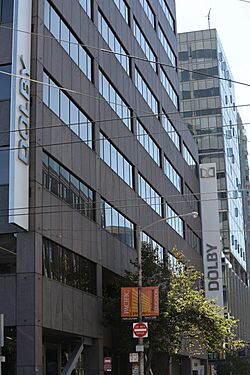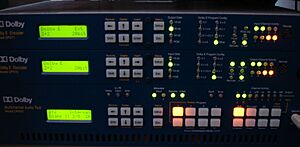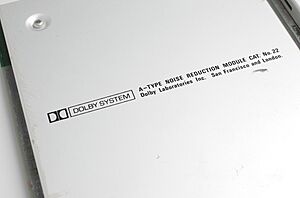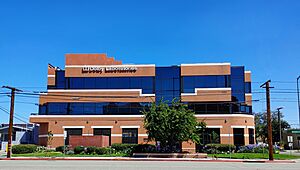Dolby facts for kids
 |
|

Headquarters in San Francisco, California
|
|
| Public | |
| Traded as |
|
| Industry |
|
| Founded | May 18, 1965 in London, England |
| Founder | Ray Dolby |
| Headquarters |
,
U.S.
|
|
Number of locations
|
30+ (2015) |
|
Area served
|
Worldwide |
|
Key people
|
|
| Products | see Technologies
|
| Services | Dolby Cinema |
| Revenue | |
|
Operating income
|
|
| Total assets | |
| Total equity | |
|
Number of employees
|
2,080 (2024) |
| Subsidiaries |
|
Dolby Laboratories, often just called Dolby, is a company from both Britain and America. They are experts in making sound clearer by reducing background noise, making audio files smaller, creating 3D sound experiences, and improving TV picture quality (called HDR). Dolby shares its cool technologies with companies that make electronics like TVs, phones, and speakers.
Contents
History of Dolby Sound
Dolby Labs was started by Ray Dolby in London, England, in 1965. In the same year, he invented the Dolby Noise Reduction system. This system helped reduce the annoying background hissing sound on cassette tape recordings. His first U.S. patent for this technology was filed in 1969.
The first company to use Dolby's noise reduction was Decca Records in the UK. Soon, other big companies like BBC and CBS Studios started buying Dolby's professional noise reduction system, called A301.
Moving to the U.S.
Ray Dolby moved the company's main office to the United States, specifically San Francisco, California, in 1976. The first product Dolby Labs made was the Dolby 301 unit. This unit used the Type A Dolby Noise Reduction system and was made for professional recording studios.
Later, Ray Dolby was convinced to create a version of his noise reduction for everyday people. He developed Type B in 1968, which was easier for consumers to use.
Improving Movie Sound
Dolby also wanted to make movie sound much better. They found that old movie sound often had a lot of background noise. To fix this, they created ways to filter out noise and improve how sound was recorded.
The first movie to use Dolby noise reduction in its mixing was A Clockwork Orange in 1971. Then, Callan (1974) was the first film to have a special Dolby-encoded soundtrack.
In 1975, Dolby released Dolby Stereo. This system not only reduced noise but also added more sound channels, making the sound feel more surrounding. The movie Lisztomania (1975) was the first to use a Dolby-encoded stereo soundtrack. By 1976, A Star Is Born featured the first true surround sound (Left-Center-Right-Surround). In less than ten years, 6,000 movie theaters around the world were using Dolby Stereo.
For home use, Dolby created Dolby Surround and later Dolby Pro Logic. These systems brought the surround sound experience from cinemas into people's homes.
Entering the Digital Age
Dolby then developed a digital surround sound system for cinemas called Dolby Stereo Digital, now known as Dolby Digital. It first appeared in the 1992 film Batman Returns.
For home theaters, Dolby Digital became popular when it was included in the DVD standard. Today, you can find Dolby Digital in HDTV, DVD players, and many satellite and cable TV systems.
Recent Developments
On February 17, 2005, Dolby became a public company, meaning its shares could be bought and sold on the New York Stock Exchange.
In 2010, Dolby introduced Dolby Surround 7.1, which added two more surround sound channels. The first movie to use this was Pixar's Toy Story 3.
In April 2012, Dolby launched Dolby Atmos, a new cinema technology that adds overhead sound, making it feel like sound is coming from all around you, even above. The first movie with Dolby Atmos was Brave. In the same year, Dolby bought the naming rights for Hollywood's Dolby Theatre, where the annual Academy Awards are held.
By July 2014, Dolby Atmos was also brought to home theaters. The TV show Game of Thrones was one of the first to use it on disc.
In May 2019, Dolby Atmos was added to hundreds of new songs, bringing immersive sound to music. In May 2020, Dolby launched Dolby.io, a platform that lets developers use Dolby technologies in their own apps, games, and websites.
In May 2025, BBC Radio 4 broadcast a program called Surrounded by Sound: Ray Dolby and the Art of Noise Reduction to celebrate Dolby Laboratories' 60th anniversary.
Dolby Technologies
Dolby has created many technologies to improve sound and video. Here are some of the main ones:
Analog Audio Noise Reduction
These systems help reduce unwanted background noise in older analog recordings.
- Dolby A: Used by professionals for tape recordings.
- Dolby NR/B/C/S: Versions for everyday people using cassette tapes.
- Dolby SR (Spectral Recording): A professional system used since 1986 to make analog recordings sound much clearer. It's still used in almost all 35mm film prints.
- Dolby HX Pro: Helps high-end tape recorders get better sound quality without needing a special decoder.
Audio Encoding and Compression
These technologies make audio files smaller while keeping good sound quality, and they create surround sound experiences.
- Dolby Digital (also known as AC-3): This format was a big step for surround sound. It supports sound from one speaker up to six speakers (called "5.1"). It started in movie theaters and then came to Laserdisc and DVD. It's now used in digital TV, Blu-ray discs, and many video game consoles.
- Dolby Digital EX: Adds a center-rear surround channel to Dolby Digital for 6.1 or 7.1 channel sound.
- Dolby Digital Plus (also known as E-AC-3): An improved version of Dolby Digital that can handle more data and is used in HD DVD and Blu-ray discs.
- Dolby Digital Live: A technology that converts any audio from a computer or game console into 5.1-channel Dolby Digital in real-time.
- Dolby E: A professional system used in TV production and broadcasting to handle surround sound. It's converted to Dolby Digital before it reaches your home TV.
- Dolby Stereo: The original analog technology for 35mm films, using four sound channels (Left, Center, Right, and Surround).
- Dolby TrueHD: Offers sound quality exactly like the original studio recording. It supports many channels and is used on HDMI devices, HD DVD, and Blu-ray discs.
- Dolby AC-4: A newer audio compression format that can handle both traditional audio channels and "audio objects" (sounds that can move around in a 3D space).
- Dolby Atmos: This technology creates immersive audio with sound coming from all directions, including above you. It uses a mix of channels and "audio objects" to place sounds precisely. It was first used in cinemas with Brave (2012 film) and later came to home theaters and video games like Star Wars Battlefront (2015 video game).
Audio Processing
These technologies enhance or change how sound is heard.
- Dolby Headphone: Makes regular stereo headphones sound like you're listening to 5.1 surround sound.
- Dolby Virtual Speaker: Makes two regular stereo speakers sound like a 5.1 surround sound system.
- Dolby Surround, Dolby Pro Logic, Dolby Pro Logic II, Dolby Pro Logic IIx, and Dolby Pro Logic IIz: These systems expand sound to more channels, making the audio experience more immersive.
- Dolby Volume: Helps keep the sound level consistent, so you don't get sudden loud or quiet parts.
- Dolby Mobile: Surround sound technology made specifically for mobile phones.
- Dolby Voice: Products for high-quality web conferencing.
Video Processing
Dolby also works on improving picture quality.
- Dolby Contrast: Improves the contrast on LCD screens with LED backlights.
- Perceptual Quantizer (PQ) / SMPTE ST 2084: A technology that allows TVs to show high dynamic range (HDR) video with very bright and detailed images. It's used in the HDR10 format.
- Dolby Vision: A special format for creating and showing HDR video with amazing colors and brightness. It supports very high resolutions and color depth. Dolby Vision content can be found on Ultra HD Blu-ray discs, streaming services, and some TVs and mobile devices.
- ICtCp: A color system designed for HDR and wide color displays, providing better color representation.
Digital Cinema
Dolby offers several technologies for modern movie theaters.
- Dolby Digital Cinema: Digital systems for movie playback.
- Dolby Surround 7.1: Adds two extra surround channels for a more immersive cinema experience.
- Dolby 3D: Technology for showing 3D movies.
- Dolby Atmos: The immersive sound system with overhead audio.
- Dolby Cinema: A premium movie theater experience developed by Dolby, competing with IMAX.
Dolby Surround Sound Systems
Dolby has developed different surround sound systems over the years. Here's a simple look at how they work:
| Decoder | Encoder | Year | What it Does | Channels |
|---|---|---|---|---|
| Dolby Stereo | Dolby MP Matrix | 1975 | Used in cinemas for 35mm films. It takes 2 channels and turns them into 4. | Front Left, Front Right, Center, and Mono Surround |
| Dolby Surround | " | 1982 | The home version of Dolby Stereo. | Front Left, Front Right, and Mono Surround |
| Dolby Stereo SR | Dolby MP Matrix | 1986 | Adds Dolby SR noise reduction to Dolby Stereo for even better sound. | Front Left, Front Right, Center, and Mono Surround |
| Dolby Pro Logic | " | 1986/1987 | An improved decoder for Dolby Stereo and Dolby Surround, accurately turning 2 channels into 4. | Front Left, Front Right, Center, and Mono Surround |
| Dolby Pro Logic II | N/A | 2000 | Can turn regular stereo sound into 5.1 surround sound. Also decodes Dolby Surround for 5.1 playback. | Front Left, Front Right, Center, Side Left, Side Right, Subwoofer |
| Dolby Pro Logic IIx | N/A | 2002 | An upgrade to PLII. It can expand stereo or 5.1 sound to 6.1 or 7.1 channels. | Front Left, Front Right, Center, Side Left, Side Right, Subwoofer, Left Back, Right Back |
| Dolby Pro Logic IIz | N/A | 2009 | Adds front height channels to PLIIx, creating 7.1 or 9.1 channel sound. | Left, Center, Right, Side Surrounds (Left/Right), Rear Surrounds (Left/Right), Subwoofer, Front Height (Left/Right) |
| Dolby Surround (2014) | N/A | 2014 | A new system that replaces Pro Logic. It can take stereo, 5.1, or 7.1 sound and play it over many speaker setups, including those with height speakers. |
Dolby Discrete Surround Systems
These systems use separate, distinct channels for each sound, offering a very precise surround experience.
| Format | Core Codec | Year | What it Does | Channels |
|---|---|---|---|---|
| Dolby Digital | AC-3 | 1986/1992/1995 | Uses separate channels for sound. It was the first to make surround sound popular. | Left, Right, Center, Left Surround, Right Surround, Low-Frequency Effects (Subwoofer) |
| Dolby Digital Surround EX | AC-3 | 1999 | Creates 6.1 or 7.1 surround sound by adding a center-rear channel. It still works with standard 5.1 systems. | Left, Right, Center, Left Surround, Right Surround, Low-Frequency Effects. Can also create a mono surround or stereo rear surrounds. |
| Dolby TrueHD | MLP | 2006 | A lossless compression system, meaning the sound is exactly like the original. It supports many channels and high-quality audio. | Up to 8 channels for Blu-ray (e.g., 7.1 surround) |
| Dolby Digital Plus | Enhanced AC-3 | 2006 | A more advanced version of Dolby Digital. It supports higher data rates and more channels, used on high-definition discs and for broadcasting. | Left, Right, Center, Side Surrounds (Left/Right), Low-Frequency Effects, Rear Surrounds (Left/Right) |
| Dolby Surround 7.1 | N/A | 2010 | A new sound format for cinemas that adds two extra rear surround channels. | Left, Center, Right, Side Surrounds (Left/Right), Rear Surrounds (Left/Right), Low-Frequency Effects |
| Dolby Atmos | Cinema: SSLAC. Consumer: Dolby Digital Plus-JOC, MLP, AC-4. | 2012 | Expands on existing surround sound by adding top speakers and "audio objects." This means sounds can be placed anywhere in a 3D space, not just in fixed channels. | Many channels, including Left, Right, Center, Low-Frequency Effects, Side Surrounds, Rear Surrounds, Top Surrounds. The number of speakers can change based on the setup. |
See also
- DTS (a competitor in digital sound)
- THX
- Dolby Theatre
External links




